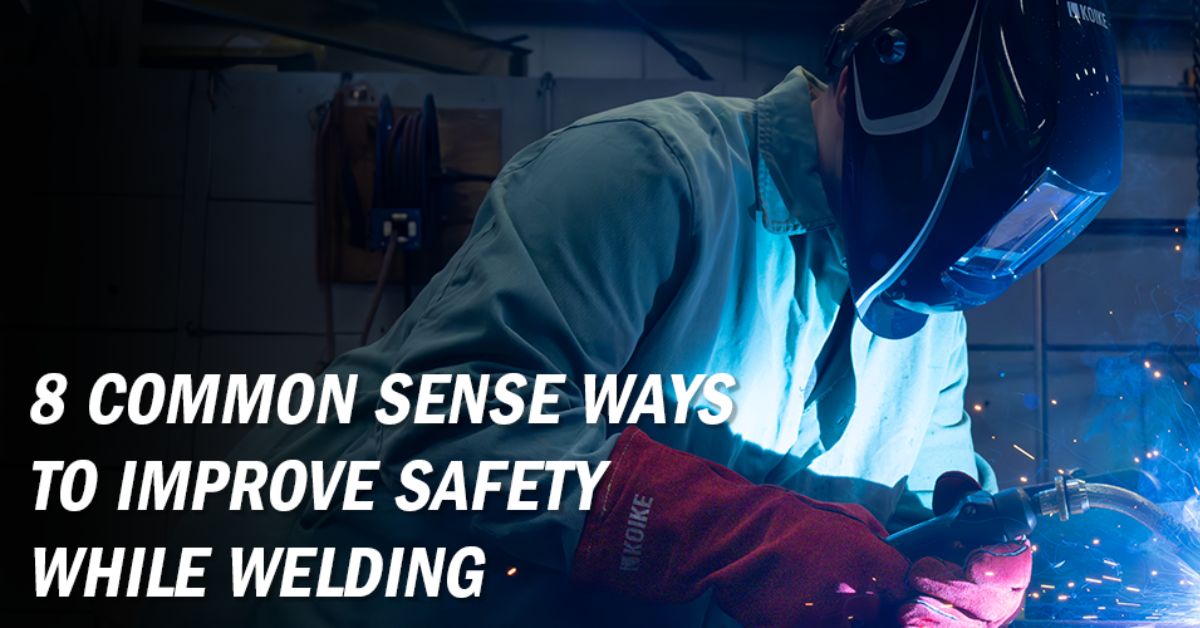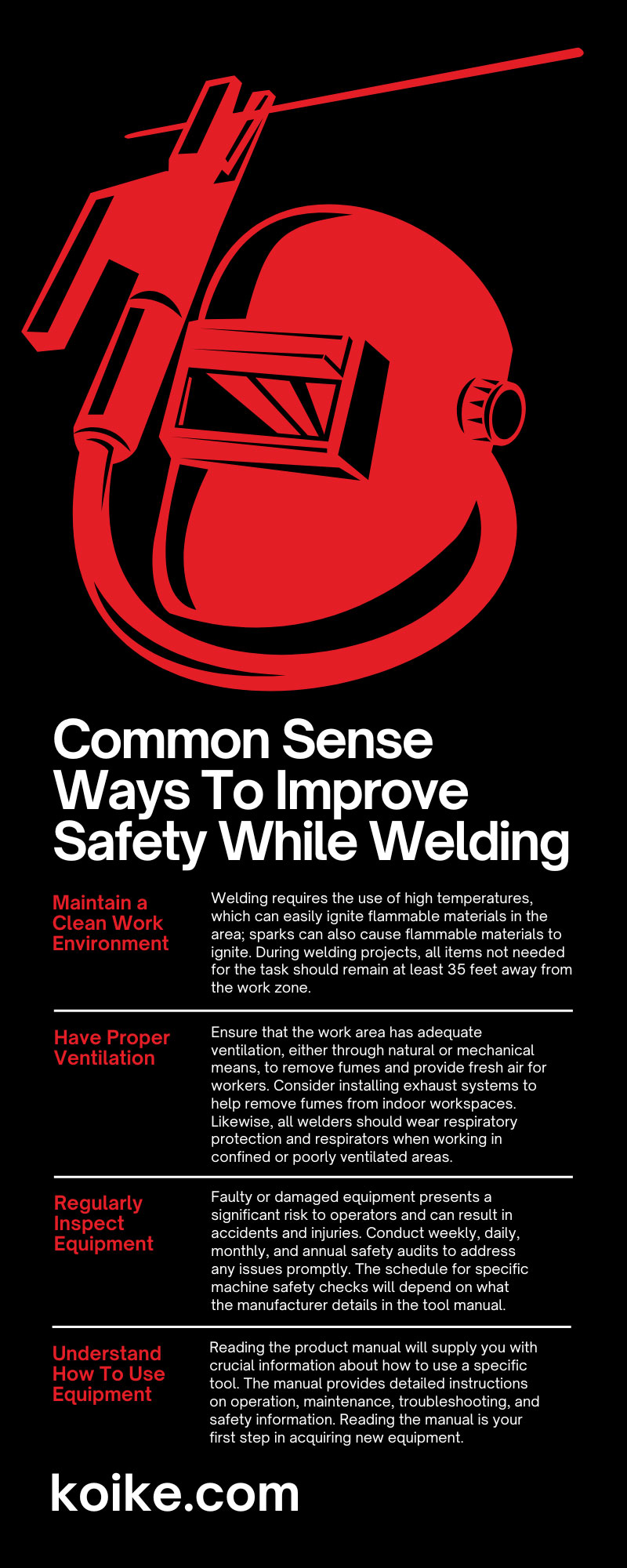8 Practical Ways to Enhance Welding Safety Measures

Safety is a priority in every industry as it ensures the well-being of workers and the smooth operation of processes. Welding is no exception, as it involves high heat, electricity, and potentially hazardous materials. Taking the right precautions makes it easier to prevent accidents and injuries while welding. In this guide, we’ll outline eight essential ways to improve safety while welding.
Wear Protective Equipment
As with many other industrial processes, personal protective equipment (PPE) is crucial to ensuring the safety of workers. Welding involves exposure to intense heat, UV radiation, and flying sparks, which can lead to serious burns if you do not have adequate protection.
Operators should have a few key items every time they set out to weld.
- Welding helmets: Protects eyes and face from intense light and heat
- Gloves: Protects hands from burns, cuts, and electric shocks
- Neck protectors: Protects the neck from the intense heat and sparks from welding
- Aprons or coveralls: Protects from sparks, UV radiation, and extreme heat
- Boots: Protects against electrical shock and protects toes from falling objects
- Respirators: Protects against inhalation of dangerous fumes and particulates
Workers should also inspect their protective equipment and report any issues with it. Welders should never use damaged PPE gear, as it will not offer the needed level of protection.
Maintain a Clean Work Environment
A clean and orderly work environment minimizes accidents during welding operations. Cluttered spaces can result in trips and falls, while spills might lead to slips. All cables, workhouses, and machinery should remain in a designated location when not in use.
Welding requires the use of high temperatures, which can easily ignite flammable materials in the area; sparks can also cause flammable materials to ignite. During welding projects, all items not needed for the task should remain at least 35 feet away from the work zone.
Have Proper Ventilation
Welding produces hazardous fumes that pose a significant health risk to operators. Without proper ventilation, these fumes can accumulate and lead to respiratory problems.
Ensure that the work area has adequate ventilation, either through natural or mechanical means, to remove fumes and provide fresh air for workers. Consider installing exhaust systems to help remove fumes from indoor workspaces. Likewise, all welders should wear respiratory protection and respirators when working in confined or poorly ventilated areas.
Regularly Inspect Equipment
Faulty or damaged equipment presents a significant risk to operators and can result in accidents and injuries. Conduct weekly, daily, monthly, and annual safety audits to address any issues promptly. The schedule for specific machine safety checks will depend on what the manufacturer details in the tool manual.
Review product manuals for all your machines and note the advised maintenance schedules; adhere to this as closely as possible. Regular maintenance and replacement of worn-out parts are critical to reducing the risk of accidents and maintaining the equipment’s optimal performance.
Pro Tip
If you experience issues with your welding tools, contact the manufacturer and inquire about repair services. It’s best to go directly to the manufacturer, as they’ll have the clearest understanding of how it should work.
Establish Safety Protocols
Creating safety protocols is another vital way to improve safety while welding. Ensure that all workers receive proper training on safe welding practices and always adhere to these protocols.
Safety protocols for welders should include:
- Procedures for handling emergencies
- Reporting unsafe conditions or equipment
- Proper storage of materials and gases
- Fire prevention measures
Schedule annual or biannual safety meetings to reinforce these protocols, address any concerns, and keep all your workers up-to-date on safety information. A well-defined emergency response plan ensures swift and effective action occurs if an accident arises.
Pro Tip
Keep fire extinguishers near all workstations and easily accessible so that workers can quickly put out any fires that start.
Understand How To Use Equipment
A welder who is well-versed in their equipment can achieve higher quality welds, maintain a safer work environment, and optimize productivity. Likewise, knowing how to use machinery eliminates the need for guesswork; making assumptions about equipment operation can lead to accidents and damage.
Reading the product manual will supply you with crucial information about how to use a specific tool. The manual provides detailed instructions on operation, maintenance, troubleshooting, and safety information. Reading the manual is your first step in acquiring new equipment.
Welders should also attend formal training sessions with hands-on experience on how to handle tools. This training will give them a comprehensive understanding of equipment operation, safety precautions, and maintenance procedures.
Pro Tip
Contact the manufacturer if you’re not sure how to use a tool or have questions about the information listed in the manual. They can provide additional resources or training to ensure proper usage.
Regularly Educate Operators
Provide all workers with comprehensive training on the safe handling of welding equipment, understanding the hazards associated with welding, and using PPE correctly. Every welder should attend annual training to stay current on the latest safety regulations, techniques, and equipment. Welding procedures and technologies continuously evolve, and remaining informed on these changes enables welders to maintain a safe working environment. The American Welding Society has a wealth of free resources on welding safety that can help make welders more well-rounded professionals.
Use Quality Equipment
Investing in quality welding equipment keeps workers safe for numerous reasons. High-quality machines are less likely to malfunction, reducing the risk of accidents and injuries. Likewise, tools that are well-made are more likely to last regular use and have built-in safety features.
Below, we will detail some areas to evaluate when you shop for welding tools.
Quality and Durability
Look for brands known for their reliability and durability. Cheap or poorly made equipment may lead to subpar results and pose a safety hazard.
To determine the quality of a manufacturer, read through their past reviews and note how long they’ve been in business. Companies with decades of experience are more likely to prioritize core values such as quality and innovation.
Power and Versatility
The power of welding equipment is important for ensuring proper fusion and achieving desired results. Look for machinery that you can optimize with welding accessory kits so that you can take on a wider range of projects.
Shop at Koike Aronson, Inc.
At Koike Aronson, we’ve spent over 100 years committed to selling the highest-quality gas cutting and welding equipment. We can provide you with all the tools and information needed to ensure a safe welding environment.
Our team of experts can help you select the right equipment for your specific needs and provide training and support to ensure proper usage. Buy your welding tools from a company you can count on for reliable machinery and service.

